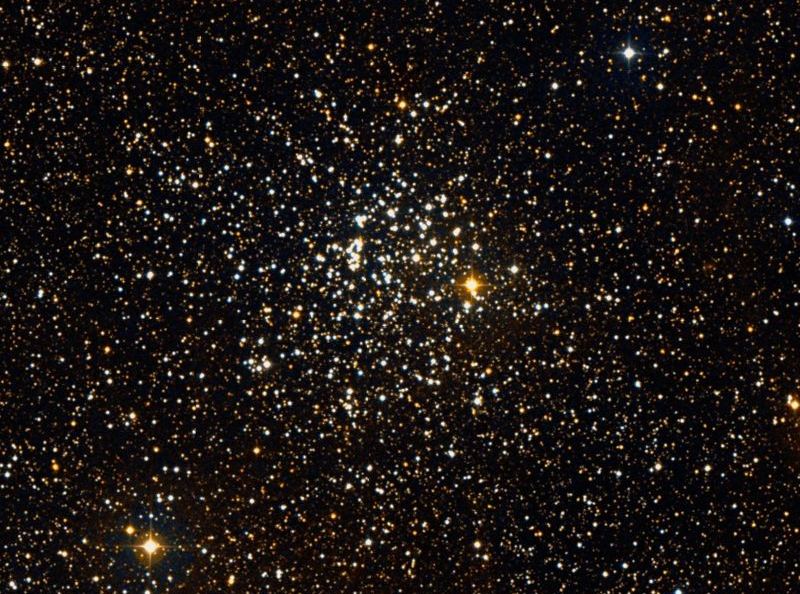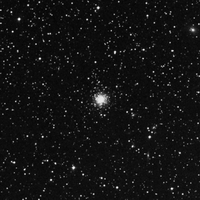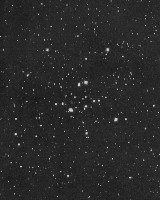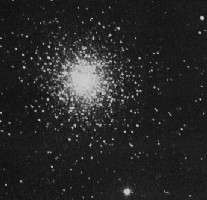



| Observer: | Tom Campbell |
| Location: | Iola, Kansas (Long: 95°24'W Lat: 37°55'N) |
| Equipment: |
8" Discovery DHQ dob Simmons 10x50 binoculars |
| Eyepieces: | 1.25" Plössls - 25mm (49x), 15mm (81x), 10mm (122x), 6.5mm (188x), 4mm (305x) |
| Time: | 8:00pm - 10:45pm CDT (01:00-03:45 UT) |
| Transparency: | Clear (8/10) |
| Seeing: | Stable (9/10) |
| Weather: | Temperatures in the lower 80s. There was little to no wind. |

The last couple of nights have been clear, but the air felt really damp so I never bothered to set up. Tonight, the sky was equally clear, but the air was warmer and drier. I didn't waste any time in setting up.
Tonight's observing plan was a potpourri of objects that I had neglected to look at on previous occasions. My telescope and binoculars each received approximately equal use, as I crossed items off my various observing lists. I had wanted to take a peek at the nova in Sagittarius, but that area of the sky was obscured by trees and houses. No matter: there were plenty of other delights to see.
| q Theta | Serpens | Double Star | 8:05pm CDT |
| 63 | RA: 1856.2 | Dec: +0412 | Mag: 4.6, 5.0 |
This is a wide double, practically located in Aquila. At low power (49x), both stars appear white, with one just barely fainter than the other. Numerous stars in the Milky Way provide a nice background to this pair. |
|||
| M11 | Scutum | Open Cluster | 8:10pm CDT |
| NGC 6705 | RA: 1851.1 | Dec: -0616 | Mag: 5.8 |
 |
BINOCULARS: This cluster is easy to find in binoculars by swinging off the tail of Aquila. It appears as a fairly bright nebulous patch. The one bright star in the cluster can be resolved near the middle of the patch. |
||
| M52 | Cassiopeia | Open Cluster | 8:20pm CDT |
| NGC 7654 | RA: 2324.3 | Dec: +6135 | Mag: 6.9 |
 |
BINOCULARS: This is a small and fairly faint fuzzy patch which can be easily found by following a line from Alpha Cas to Beta Cas and extending it about twice the distance. Several bright stars in the area help to make M52 stand out as a fuzzy patch rather than an out-of-focus star. It becomes more noticeable as you slowly sweep the area. |
||
| NGC 7006 | Delphinus | Globular Cluster | 8:40pm CDT |
| RA: 2101.5 | Dec: +1611 | Mag: 10.6 | |
 |
This globular is faint and easily overlooked. Carefully sweeping the area at 81x, I was able to find it, however. The best view was at 125x, where the core appeared nearly stellar with averted vision, and fading steadily to the outer edges. It is difficult to tell, but the shape didn't appear quite round. This isn't a very impressive globular from these skies. |
||
| a Alpha | Capricornus | Double Star | 8:55pm CDT |
| 5/6 | RA: 2017.6 | Dec: -1230 | Mag: 3.8, 4.2 |
These stars have a very wide separation. Both are bright and yellow, with one component slightly fainter. Even at low powers, the stars are too wide to look good in my telescope. They are great looking in my binoculars, however. |
|||
| b Beta | Capricornus | Double Star | 9:00pm CDT |
| Dabih | RA: 2021.0 | Dec: -1447 | Mag: 3.1, 6.2 |
This wide pair has an interesting contrast in magnitudes. The brightest component is yellow, looking very much like one of the members of Alpha Cap. The companion star is a couple of magnitudes fainter, and is bluish-white. Through binoculars, both Alpha Cap and Beta Cap are easily resolvable and are in the same field of view. This makes for a striking sight. |
|||
| 94 | Aquarius | Double Star | 9:15pm CDT |
| S2998 | RA: 2319.1 | Dec: -1328 | Mag: 5.2, 7.6 |
This is a nice double that can be split at 49x, although 81x provides a nicer view. The primary is yellow-white and the fainter companion is bluish-gray. |
|||
| M34 | Perseus | Open Cluster | 9:35pm CDT |
| NGC 1039 | RA: 0242.1 | Dec: +4245 | Mag: 5.2 |
 |
BINOCULARS: This somewhat spread-out open cluster looks nice through binoculars. With direct vision, it looks like a fuzzy patch of light, but averted vision resolves four or five individual stars among the nebulosity. |
||
| M15 | Pegasus | Globular Cluster | 9:55pm CDT |
| NGC 7078 | RA: 2130.0 | Dec: +1210 | Mag: 6.3 |
 |
BINOCULARS: This globular is easily detected as a small round fuzzy patch of light within a triangle of stars. It looks to be perhaps a little brighter than M13, but not quite as large. |
||
| i Iota | Triangulum | Double Star | 10:15pm CDT |
| 6 | RA: 0212.4 | Dec: +3018 | Mag: 5.2, 6.6 |
The best view of this fairly close double is at 188x. The primary component is yellow-white and the fainter companion is blue-white. The bluish cast of the secondary star seemed more pronounced at 305x. I could easily split the pair at 125x, but I couldn't at 81x. |
|||
| NGC 40 | Cepheus | Planetary Nebula | 10:30pm CDT |
| PK 120+9.1 | RA: 0013.0 | Dec: +7231 | Mag: 10.7 |
 |
This is an unusual looking planetary nebula. The round-shaped nebulosity is somewhat large and faint, but the central star is bright and easily seen. The best view was provided at 305x. Averted vision makes the nebulosity easier to see. It reminds me of a target, with a bright bullseye and fainter outer ring. No colors were detected. |
||